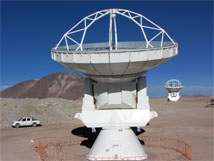
Figure 1. Two ALMA antennas have measured fringes at three frequency bands at the 5000m elevation ALMA Array Operations Site.

Figure 1. Two ALMA antennas have measured fringes at three frequency bands at the 5000m elevation ALMA Array Operations Site.
On 23 September, the first ALMA antenna was delivered to the 5000m Array Operations Site (AOS). It was joined on 16 October by a second antenna which was placed on pad 109; on 17 October the first antenna was moved from its location near the Technical Building to pad 96, about 160 meters away. Shortly afterward connections to the rest of the ALMA system had been made and by 21 October fringes were detected toward the Orion SiO maser and 3C84 at 3mm wavelength. Similar success was also soon achieved at 230 GHz (Band 6) and at 345 GHz. Many people contributed to this effort that was led by Robert Lucas with Tzu-Chiang Shen, Rodrigo Araya, Rodrigo Olguin, Juan Pablo Caram, and Antonio Hales; many others contributed to this success, on a course charted by the Assembly, Integration and Verification, Commissioning and Science Verification, and Science Operations teams. Project Scientist Richard Hills noted "Although all of the components that make up the integrated ALMA telescope are thoroughly tested prior to being sent to the AOS, the coherent detection of these sources from the high site using all of the combined equipment represents a unique test of the system as a whole. This successful operation means that many of the problems associated with getting cutting-edge technology working in such harsh conditions have been solved. We are very much looking forward to adding the third antenna which will allow us to verify more of the software and hardware by obtaining phase closure." (Further information on the fringe acquisition)
A third ALMA antenna is expected to join the first two by Thanksgiving as the fledgling array grows. Concrete has been poured for all of the 192 antenna stations that ALMA requires. After initial testing, the focus of early interferometry in 2010 will move to the compact cluster of stations near the center of the array.

A recent view from the holography tower shows the Operations Support Facility. Notable are the Alcatel antennas in the left foreground. Several antennas may be seen in various stages; dummy front end and back end racks have now been fit into the receiver cabins as an early test. Note that the carbon fiber backup structure arrives in two halves (far left) which are then glued together in one of the building in the foreground. On the right, several antennas are under test at the Operations Support Facility Technical Building.
Meanwhile new equipment continues to arrive and march through its tests at the lower-elevation ALMA Operations Support Facility (OSF). The third and fourth North American antennas have now been accepted there, and two additional antennas should be accepted in December. The first of the 7m antennas has completed its journey from Japan and is now awaiting assembly at the Mitsubishi area of the OSF. Several antennas in the European antenna (Alcatel) area will be undergoing receiver cabin tests, including equipping them with dummy receiver and signal processing equipment.